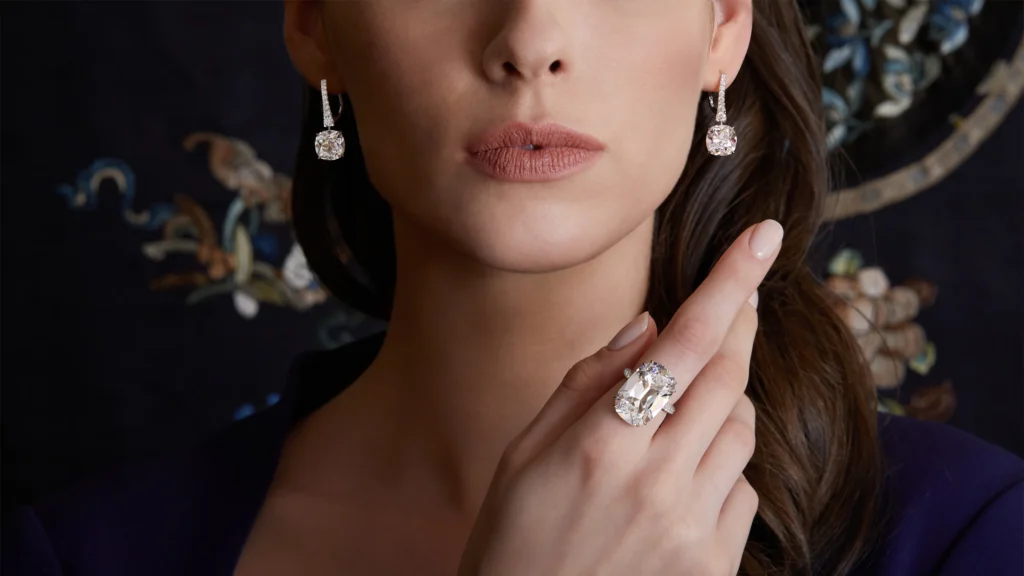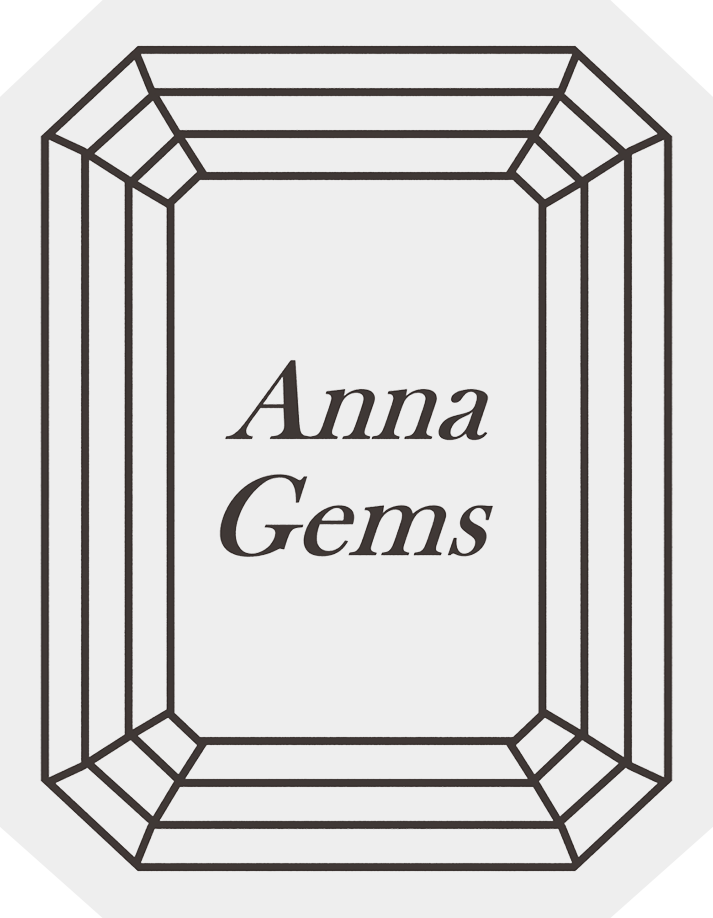DIAMOND
Name
Formed in the mantle at the very heart of the earth, Diamond derives its name from the Greek ‘adamas’, which means ‘unconquerable’, certainly appropriate for the hardest and one of the most valuable of all gemstones. The only gemstone comprised of a single element, Diamonds are crystalline carbon. As a 10 on Mohs scale, they are the hardest known natural mineral. Most are between one billion to 3.3 billion years old.
HISTORY OF DIAMONDS
Greek philosophers thought Diamonds were ‘alive’ with celestial spirits, Romans thought they were tears of the gods or splinters from falling stars, while Hindus believed they were created by lightning striking rocks.
From the middle ages to the renaissance, they were purported to possess a variety of esoteric abilities to counter life’s troubles, including instilling bravery, courage, invincibility, strength and virtue, as well as the power to drive away nightmares.

4C’s
No two diamonds are alike. Each one is unique. This is why over the years a universal standard for identifying diamonds has been set. The quality and value of a diamond is defined according to the 4Cs: carat, colour, clarity and cut.
The creation of the Diamond 4Cs and the GIA International Diamond Grading System meant two very important things: diamond quality could be communicated in a universal language, and diamond customers could now know exactly what they are purchasing.
Diamonds Chart

4C’s of Diamonds
Carat
Carat measures a diamond’s weight and size. The term “carat” is derived from the carob seeds that were used
to balance scales in ancient times.
Today’s metric carat is equal to 200 milligrams, or one-fifth of a gram, and there are approximately 142 carats to
an ounce. Carats are further divided into points, with 100 points per carat. A half-carat diamond may be referred
to as a 50-point stone.
Because large diamonds are rare, they generally have a greater value per carat. When considering the value of a
diamond or gemstone, two diamonds or gems of equal carat weight can have differing price points based on
the other Cs (clarity, cut, color).
Clarity
A diamond’s clarity is affected by any external and internal characteristics created by nature when the diamond was formed or as a result of the cutting process.
Characteristics such as internal spots or lines are called inclusions. Although these marks make each stone unique, the fewer the inclusions, the more valuable the stone. Inclusions can sometimes interfere with the passage of light through the stone, diminishing the sparkle and value of the diamond. Inclusions are not generally visible to the naked eye without magnification. Blemishes, which are external imperfections that occur on the surface of the diamond, also affect the diamond clarity grade.
According to the quality analysis system of the Gemological Institute of America (GIA), clarity is graded on a scale ranging from Flawless (Fl) to Imperfect (I). Only a tiny percentage of diamonds ever achieve a clarity grade of Flawless. The closer a diamond is to Flawless, the higher the value of the diamond.
It’s important to remember that clarity is based on a grading scale and could fall between two specifications – for example, if a diamond is graded as an SI1, it could be incredibly close to a VS2.
Diamond Clarity Scale

Color
Diamonds come in every color of the spectrum, but the most popular are colorless. Truly colorless, pure white diamonds are extremely rare and, therefore, the most costly.
Laboratories, like the Gemological Institute of America (GIA), grade a diamond’s color using a color scale based on how far they deviate from the purest white.
Diamonds Color Chart

The best way to see the true color of a diamond is by looking at it against a white surface. Colorless diamonds are graded D, E or F. All three grades are considered colorless but with slightly
decreasing transparency. Color grading continues down through the alphabet, with each letter designating a slight darker or warmer tint.
Colored Diamonds
Diamonds also come in a spectrum of majestic colors, from red and canary yellow to blue, green and pink. These colorful diamonds, known as fancies, are valued for their depth of color, just as white diamonds are valued for their lack of color. Fancy diamonds are graded in order of increasing intensity from Faint, Very Light, Light, Fancy Light, Fancy, Fancy Intense, Fancy Vivid, Fancy Dark and Fancy Deep. These colored diamonds are rarer than colorless and tend to have higher costs.
Diamond color grades are determined by professionals under ideal circumstances, a situation seldom duplicated outside of a laboratory. Similar to clarity, color is graded on a range – a diamond with a G color grade could be very close to an F or to an H.
Cut
The cut is one of the most important quality factors of a diamond, as it affects the diamond’s optical and physical properties like brilliance – how a diamond reflects light and “sparkles.”
Diamond shape is different than cut – shape only refers to the diamond’s form as a whole – such as heart, round, princess, oval – whereas the cut refers to how the jeweler physically cuts the diamond stone into its shape and to the proportions and symmetry that achieve optimal light dispersion, which affects a diamond’s quality and price.


A diamond’s light reflection, known as brilliance, is an extremely important factor in evaluating the quality of a diamond’s cut. A poorly cut diamond will actually lose light and appear dull.
The most common cut, the round brilliant, has 58 facets, or small, flat, polished planes designed to yield the maximum amount of light reflected back to the viewer.
The widest circumference of a diamond is known as the girdle. Above the girdle of a brilliant cut diamond are 32 facets plus the table, which is the largest and topmost facet. Below the girdle are 24 facets plus the culet, or point.
Proportion diagrams will typically include the following information:
- Depth: The height of a gemstone measured from the culet to the table
- Table: Located at the top of the diamond, the table is the largest facet of a diamond
- Girdle: Range of girdle thickness
- Culet: Appearance, or lack thereof, of the culet facet
A diamond’s cut grade impacts four aspects of the stone’s optical and physical properties:
- Luster: The quality and amount of light that is reflected off just the surface of the diamond.
Luster is directly related to the hardness of the stone and the quality of its polish. - Brilliance: The amount of white light that is returned to the eye from both internal and external surfaces. Brilliance is determined by the quality of the diamond’s polish and the number and size of inclusions inside the gem.
- Dispersion: The display of spectral or rainbow colors seen coming from the inside of a diamond. Often referred to as “fire,” dispersion is directly related to how well the stone is proportioned.
- Scintillation: A diamond will show scintillation, or “sparkle,” when movement is involved. The viewer, the light source or the diamond itself must be in motion for scintillation to occur.
Despite all of these specifications, the most important part of choosing a diamond is to finding one that appeals to you personally. While it is beneficial to understand the technical aspects of diamonds, it is most essential to fall in love with your diamond


